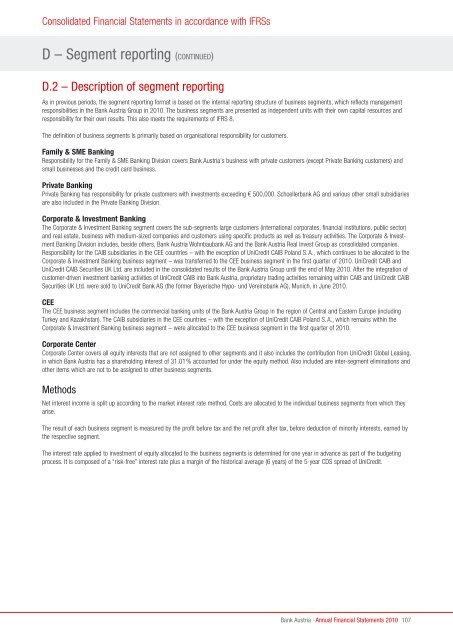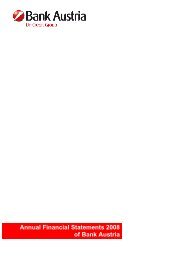Annual Financial Statements 2010 of Bank Austria
Annual Financial Statements 2010 of Bank Austria
Annual Financial Statements 2010 of Bank Austria
Create successful ePaper yourself
Turn your PDF publications into a flip-book with our unique Google optimized e-Paper software.
Consolidated <strong>Financial</strong> <strong>Statements</strong> in accordance with IFRSs<br />
D – Segment reporting (CoNTINuED)<br />
D.2 – Description <strong>of</strong> segment reporting<br />
As in previous periods, the segment reporting format is based on the internal reporting structure <strong>of</strong> business segments, which reflects management<br />
responsibilities in the <strong>Bank</strong> <strong>Austria</strong> Group in <strong>2010</strong>. The business segments are presented as independent units with their own capital resources and<br />
responsibility for their own results. This also meets the requirements <strong>of</strong> IFRS 8.<br />
The definition <strong>of</strong> business segments is primarily based on organisational responsibility for customers.<br />
Family & SME <strong>Bank</strong>ing<br />
Responsibility for the Family & SME <strong>Bank</strong>ing Division covers <strong>Bank</strong> <strong>Austria</strong>’s business with private customers (except Private <strong>Bank</strong>ing customers) and<br />
small businesses and the credit card business.<br />
Private <strong>Bank</strong>ing<br />
Private <strong>Bank</strong>ing has responsibility for private customers with investments exceeding € 500,000. Schoellerbank AG and various other small subsidiaries<br />
are also included in the Private <strong>Bank</strong>ing Division.<br />
Corporate & Investment <strong>Bank</strong>ing<br />
The Corporate & Investment <strong>Bank</strong>ing segment covers the sub-segments large customers (international corporates, financial institutions, public sector)<br />
and real estate, business with medium-sized companies and customers using specific products as well as treasury activities. The Corporate & Investment<br />
<strong>Bank</strong>ing Division includes, beside others, <strong>Bank</strong> <strong>Austria</strong> Wohnbaubank AG and the <strong>Bank</strong> <strong>Austria</strong> Real Invest Group as consolidated companies.<br />
Responsibility for the CAIB subsidiaries in the CEE countries – with the exception <strong>of</strong> UniCredit CAIB Poland S.A., which continues to be allocated to the<br />
Corporate & Investment <strong>Bank</strong>ing business segment – was transferred to the CEE business segment in the first quarter <strong>of</strong> <strong>2010</strong>. UniCredit CAIB and<br />
UniCredit CAIB Securities UK Ltd. are included in the consolidated results <strong>of</strong> the <strong>Bank</strong> <strong>Austria</strong> Group until the end <strong>of</strong> May <strong>2010</strong>. After the integration <strong>of</strong><br />
customer-driven investment banking activities <strong>of</strong> UniCredit CAIB into <strong>Bank</strong> <strong>Austria</strong>, proprietary trading activities remaining within CAIB and UniCredit CAIB<br />
Securities UK Ltd. were sold to UniCredit <strong>Bank</strong> AG (the former Bayerische Hypo- und Vereinsbank AG), Munich, in June <strong>2010</strong>.<br />
CEE<br />
The CEE business segment includes the commercial banking units <strong>of</strong> the <strong>Bank</strong> <strong>Austria</strong> Group in the region <strong>of</strong> Central and Eastern Europe (including<br />
Turkey and Kazakhstan). The CAIB subsidiaries in the CEE countries – with the exception <strong>of</strong> UniCredit CAIB Poland S.A., which remains within the<br />
Corporate & Investment <strong>Bank</strong>ing business segment – were allocated to the CEE business segment in the first quarter <strong>of</strong> <strong>2010</strong>.<br />
Corporate Center<br />
Corporate Center covers all equity interests that are not assigned to other segments and it also includes the contribution from UniCredit Global Leasing,<br />
in which <strong>Bank</strong> <strong>Austria</strong> has a shareholding interest <strong>of</strong> 31.01% accounted for under the equity method. Also included are inter-segment eliminations and<br />
other items which are not to be assigned to other business segments.<br />
Methods<br />
Net interest income is split up according to the market interest rate method. Costs are allocated to the individual business segments from which they<br />
arise.<br />
The result <strong>of</strong> each business segment is measured by the pr<strong>of</strong>it before tax and the net pr<strong>of</strong>it after tax, before deduction <strong>of</strong> minority interests, earned by<br />
the respective segment.<br />
The interest rate applied to investment <strong>of</strong> equity allocated to the business segments is determined for one year in advance as part <strong>of</strong> the budgeting<br />
process. It is composed <strong>of</strong> a “risk-free” interest rate plus a margin <strong>of</strong> the historical average (6 years) <strong>of</strong> the 5-year CDS spread <strong>of</strong> UniCredit.<br />
<strong>Bank</strong> <strong>Austria</strong> · <strong>Annual</strong> <strong>Financial</strong> <strong>Statements</strong> <strong>2010</strong><br />
107
















